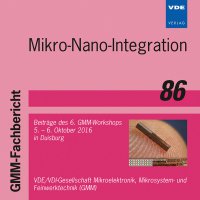Asymmetric resonance frequency analysis of in-plane electrothermal silicon cantilever for nanoparticle detection
Konferenz: Mikro-Nano-Integration - 6. GMM-Workshop
05.10.2016 - 06.10.2016 in Duisburg, Deutschland
Tagungsband: Mikro-Nano-Integration
Seiten: 6Sprache: EnglischTyp: PDF
Persönliche VDE-Mitglieder erhalten auf diesen Artikel 10% Rabatt
Autoren:
Bertke, Maik; Hamdana, Gerry; Wu, Wenze; Wasisto, Hutomo Suryo; Peiner, Erwin (Institute of Semiconductor Technology (IHT), Braunschweig University of Technology, Hans-Sommer-Str. 66, 38106 Braunschweig, Germany & Laboratory for Emerging Nanometrology (LENA), Langer Kamp 6a, 38106 Braunschweig, Germany)
Marks, Markus (Institute of Semiconductor Technology (IHT), Braunschweig University of Technology, Hans-Sommer-Str. 66, 38106 Braunschweig, Germany)
Inhalt:
An analysis of asymmetric resonance frequencies of silicon cantilevers for a portable, cost efficient, cantilever based nanoparticle detector (Cantor) is described. The cantilever is used as mass-sensitive microbalance. Therefore, it is excited in the first in-plane resonance mode and the shift of its resonance frequency (f0) caused by the deposition of nanoparticles (NPs) is measured. The cantilever sensors are manufactured from silicon by bulk-micromachining techniques. They contain an integrated piezo resistive Wheatstone Bridge (WB) and a thermal actuator. To optimize the sensor performance different geometrical designs are fabricated and characterized. For this application the most significant characterisation parameters are f0 and the quality factor (Q). Both parameters have large influence on sensitivity and efficiency of the NP detector. Regarding the asymmetric resonance behaviour, a new fitting function based on the Fano resonance and a method to calculate Q are developed. This function replaces the conventionally used function of the simple harmonic oscillator (SHO). A phase locked loop (PLL) circuit is developed for f0 tracking. In a long-term test, a frequency stability of 0.753 Hz and an Allan variance of 3.77 x 10-6 is reached. Using the proposed method of fitting asymmetric resonant curves and the direct calculation of the parameters, useful results to optimize a next generation of Cantor are expected.


